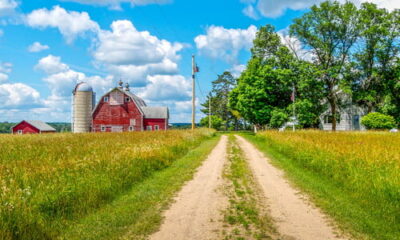

Environment
4 Ways to Make Farms More Eco-Friendly
While farms are deemed helpful in the economic development of a country, sadly, traditional farming techniques have several drawbacks. There are tendencies where it often produces large amounts of toxic fertilizers and chemical pesticides, which, in turn, have adverse effects on the soil, water, and even on the climate. It may even contribute to global warming that’s experienced across the planet. If this is the case, then the environment will gradually be destroyed, and it would be impossible for farmers to push through with their job.
However, innovative farmers and scientists have decided to introduce a different farming system that’s more sustainable and eco-friendlier. There are now ways how you can, as a farmer, pursue this livelihood while minimizing or preventing environmental damage. This would not cost you a single cent, and the results would surely be very much rewarding.
1. Choose the Right Tools and Equipment
Keep in mind that the equipment you use should be built to last. Choosing the right farming tool is integral in keeping a sustainable farming way because it reduces waste and efficiently offers you more cost-effective and less-hassle farming. It’s highly suggested to only change equipment if it’s for upgrade or if it’s damaged and can no longer be repaired.
If it’s still working and is feasible, utilize it no matter how old it is since this is a big help in preventing new manufacture of equipment. Make sure to regularly sanitize and clean it thoroughly just so it won’t cause any hazards nor produce invasive species that may be destructive to crops.
Aside from the equipment or machinery, a way to make farms eco-friendly is to be mindful of the construction materials that you’ll be using in building structures. Don’t merely focus on the price tag. Not all affordable materials are high quality. Always opt for materials that are durable and can withstand wear and tear. For example, if you’re used to using carbon steel in building a farm structure, but you’ve noticed that it gets rust easily, then opt for agricultural steel buildings built to last.
2. Plant Cover Crop
Cover crops are those plants you cultivate not for the aim of harvesting them but rather to just simply cover the soil. Cover crops offer great assistance in the management of soil erosion, soil quality, fertility, pests, weeds, diseases, water, wildlife, and the overall biodiversity in a particular farm. Agricultural studies have also revealed that it helps in the addition of organic matter to the soil, attracts the right pollinators, increases crop yields, and improves crop diversity.
Their presence would also contribute to the resilience of the crop during La Niña and El Niño seasons. In incorporating cover crops in your farm, you should first identify your purpose in the first place. Do you wish to grow such plants to help prevent soil erosion? To moisturize the soil? Or to provide weed control? The type of cover crop you should plant is dependent on what objective you aim to achieve.
3. Don’t Overplant Landscapes
Overplanting landscapes prevents the variety of crops on the farm. You must be aware that variety is helpful and must be considered in farming. Overplanting can produce disease and even contaminate the nutrients absorbed by the plants and the soil. You can resolve this issue by planting a wide range of crops that attract the right kind of insects that won’t overtax the soil.
Sustainable farming recognizes the presence and importance of the less cultivated areas since these help in controlling erosion, nutrient runoff, and promoting biodiversity. Aside from this, having a variety of crops in a landscape is not just eco-friendly but genuinely satisfying to look at.
4. Rotate Crops
Cultivating the same crops repetitively in the same place annually may be convenient for you; however, it’ll have a negative effect on the long-term health of your farm in the long run. You shouldn’t just plant a variety of crops in a landscape, but you should also make sure to rotate its positions. Doing so will aid in the promotion of healthier soil and reinforcement of pest control, especially those pests that thrive in one crop and die in another.
There’s what you call intercropping, in which you can plant two kinds of crops at the same time in the same area. This will promote biodiversity in a farm, which will eventually help the environment and prevent such destructive occurrences. Intercropping also allows you to design your landscapes in a much more rich and physically appealing way. Aesthetically pleasing and eco-friendly at the same time.
Final Thoughts
While it’s tempting to just abide by the traditional farming system because of your living conditions, just remember that doing it in an eco-friendly way is also for you and for future generations. As you can see, it just requires you to tweak your routine a little and don’t demand total change, so all you need to do is to restructure your farming strategy. After all, considering the importance of sustainability will provide you a healthy crop that you can consistently harvest for a lifetime.


 Environment10 months ago
Environment10 months agoAre Polymer Banknotes: an Eco-Friendly Trend or a Groundswell?

 Environment11 months ago
Environment11 months agoEco-Friendly Home Improvements: Top 7 Upgrades for 2025

 Features9 months ago
Features9 months agoEco-Friendly Cryptocurrencies: Sustainable Investment Choices

 Features10 months ago
Features10 months agoEco-Friendly Crypto Traders Must Find the Right Exchange




















